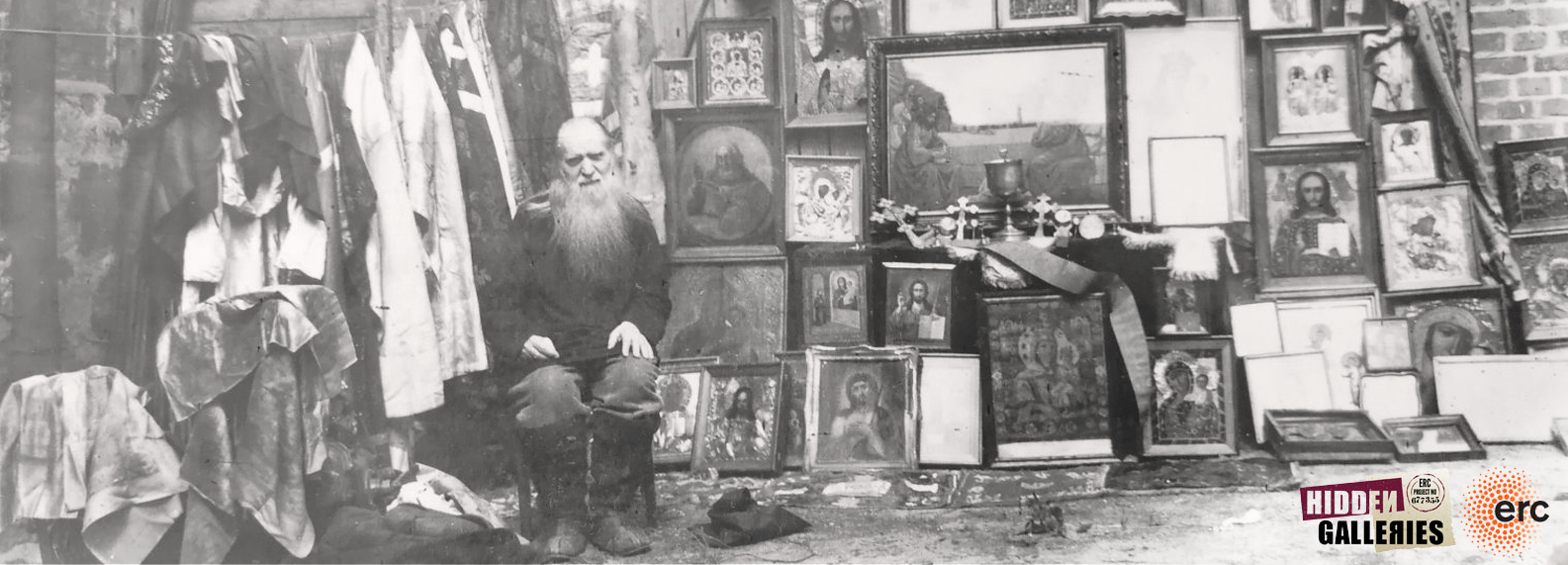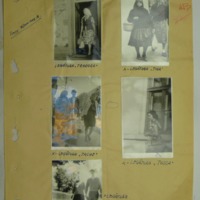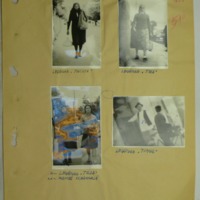Surveillance of underground Greek Catholic believers Romania
Item
Title
Surveillance of underground Greek Catholic believers Romania
Urmărire a unor credincioși greco-catolici clandestini
Description
This two-page collage of photographs represent Greek Catholic believers coming to underground services and meetings with Alexandru Todea the underground Greek Catholic bishop in Reghin, Mureș county in the mid 1960s. The images come from the informative file on Bishop Alexandru Todea that was opened upon his release from prison in 1964 as part of the general Amnesty Decree. The photo collage was sent by the Securitate officers from Mureș region to the central office in Bucharest with the description of the individuals represented in the pictures.
The pictures were the result of a longer period of surveillance of the visitors to the house where Todea was residing. They were classified and selected from a larger pool of people, categorised as people who often visited and people who visited him seldomly. The surveillance operation also identified the meeting places, either permanent or provisional (two houses and a place of work).
The two-page collage and the documents that explain it help us to understand the work of the Securitate in surveilling underground religious communities. For example, the photographed individuals are identified with aliases. In the description, they are identified with names, the names of parents, place and date of birth, current domicile and how many years the person attended school and sometimes also their employment history appears as well.
The focus in the description is also on gender and age. Men were considered more important in the underground religious communities as they owned the houses where meetings and religious services took place. However, one can see from the collage that women made up the overwhelming majority of the visitors. The secret police also track the young men and women that participate since they represented the future of the community and their resilience.
The majority of the people of the network were peasants or lived in the countryside according not only to the description but also to the way they are dressed; most women wore headscarves and aprons, the men white trousers and shirt with a dark sleeveless overcoat and a traditional hat. Also, one can see in the pictures that the women carry large shoulder bags and baskets that are traditionally used to take goods to sell at the town market. These images also shows the interest that the secret police had in the way the underground hierarchy of the Greek Catholic Church made their living since they were not employed. They assumed, correctly at least for the early years after their prison release, that peasants brought food to support their clergy.
The two-page photo collage is part of CNSAS file I3470, volume 2. The collage is attached at the end of the volume along with the description of the photographs, the short bios of the persons and the description of the meeting places.
The pictures were the result of a longer period of surveillance of the visitors to the house where Todea was residing. They were classified and selected from a larger pool of people, categorised as people who often visited and people who visited him seldomly. The surveillance operation also identified the meeting places, either permanent or provisional (two houses and a place of work).
The two-page collage and the documents that explain it help us to understand the work of the Securitate in surveilling underground religious communities. For example, the photographed individuals are identified with aliases. In the description, they are identified with names, the names of parents, place and date of birth, current domicile and how many years the person attended school and sometimes also their employment history appears as well.
The focus in the description is also on gender and age. Men were considered more important in the underground religious communities as they owned the houses where meetings and religious services took place. However, one can see from the collage that women made up the overwhelming majority of the visitors. The secret police also track the young men and women that participate since they represented the future of the community and their resilience.
The majority of the people of the network were peasants or lived in the countryside according not only to the description but also to the way they are dressed; most women wore headscarves and aprons, the men white trousers and shirt with a dark sleeveless overcoat and a traditional hat. Also, one can see in the pictures that the women carry large shoulder bags and baskets that are traditionally used to take goods to sell at the town market. These images also shows the interest that the secret police had in the way the underground hierarchy of the Greek Catholic Church made their living since they were not employed. They assumed, correctly at least for the early years after their prison release, that peasants brought food to support their clergy.
The two-page photo collage is part of CNSAS file I3470, volume 2. The collage is attached at the end of the volume along with the description of the photographs, the short bios of the persons and the description of the meeting places.
Acest colaj de două pagini de fotografii îi reprezintă pe credincioșii greco-catolici care vin la slujbe clandestine și întâlniri cu Alexandru Todea, episcopul greco-catolic din Reghin, județul Mureș, la mijlocul anilor '60. Imaginile provin din dosarul informativ al episcopului Alexandru Todea care a fost deschis la eliberarea sa din închisoare în anul 1964, ca parte a Decretului general de amnistie. Colajul foto a fost trimis de ofițerii Securității din regiunea Mureș la sediul central din București cu descrierea persoanelor reprezentate în imagini.
Fotografiile au fost rezultatul unei perioade mai lungi de supraveghere a vizitatorilor casei în care locuia Todea. Au fost clasificați și selectați dintr-un grup mai mare de oameni, clasificați ca persoane care au vizitat adesea și persoane care l-au vizitat rar. Operațiunea de supraveghere a identificat și locurile de întâlnire, fie permanente, fie provizorii (două case și un loc de muncă).
Colajul de două pagini și documentele care îl explică ne ajută să înțelegem activitatea Securității în supravegherea comunităților religioase clandestine. De exemplu, persoanele fotografiate sunt identificate cu pseudonime. În descriere, acestea sunt identificate cu nume, numele părinților, locul și data nașterii, domiciliul actual, câți ani a urmat școala și, uneori, apare și istoricul angajării.
Accentul din descriere se pune și pe sex și vârstă. Bărbații erau considerați mai importanți în comunitățile religioase clandestine, deoarece dețineau casele unde aveau loc întâlniri și slujbe religioase. Cu toate acestea, din colaj se poate observa că femeile alcătuiau majoritatea covârșitoare a vizitatorilor. Poliția secretă urmărește, de asemenea, pe tinerii și bărbații care participă, deoarece au reprezentat viitorul comunității și rezistența acesteia.
Majoritatea oamenilor din rețea erau țărani sau trăiau la țară, nu numai în funcție de descriere, ci și din modul în care sunt îmbrăcați; majoritatea femeilor purtau baticuri și șorțuri, bărbații pantaloni și cămașă albă cu o vestă neagră și o pălărie tradițională. De asemenea, în imagini se vede că femeile poartă desăgi mari pe umăr și coșuri care sunt folosite în mod tradițional pentru a lua bunuri pentru a le vinde la piața orașului. Aceste imagini arată, de asemenea, interesul pe care poliția secretă l-a avut asupra modului în care ierarhia clandestină a Bisericii Greco-Catolice și-a câștigat existența din moment ce nu erau angajați. Ei au presupus, corect cel puțin în primii ani de la eliberarea din închisoare, că țăranii aduceau alimente pentru a-și întreține clerul.
Colajul foto de două pagini face parte din dosarul CNSAS I3470, volumul 2. Colajul este atașat la sfârșitul volumului împreună cu descrierea fotografiilor, biografia scurtă a persoanelor și descrierea locurilor de întâlnire.
Subject
Communism--Romania
Communism--Romania--History--20th century
Communism and religion
Catholic Church--Byzantine rite, Greek
Material culture--Religious aspects
Romania. Securitatea
Creator
Anca Sincan
Source
Consiliul Național pentru Studierea Arhivelor Securității (CNSAS) I0003470, volume 2
Publisher
Date
1966
Rights
This project has received funding from the European Research Council (ERC) under the European Union’s Horizon 2020 research and innovation programme No . 677355
Format
jpeg
Language
RO
Type
photo
Identifier
CNSAS, I0003470, volume 2
Coverage
20th century, Romania
Bibliographic Citation
Anca Sincan, Surveillance images of underground Greek Catholic believers
Date Created
2019


